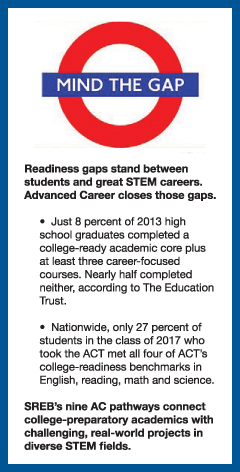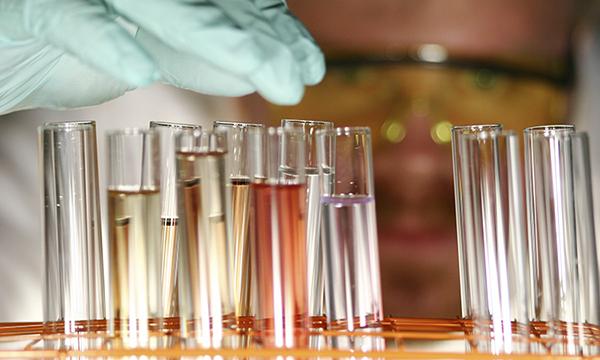Inspiring Students to Explore STEM with SREB’s Advanced Career Courses
How AC’s nine pathways connect classrooms, college and the careers of the future
As you know, science, technology, engineering and math (STEM) skills are in high demand in today’s fast-paced, technology-driven economy. Leading employers prize job candidates with strong communication and teamwork skills who anticipate workplace problems and can apply literacy, math and technical know-how to solve them. (Learn more in this Business Roundtable report).
Good jobs are abundant for individuals with skills like these in such high-paying fields as advanced manufacturing, energy, global logistics, health care and information technology. What’s more, at least 30 million of these good jobs require less than a bachelor’s degree.
Our job as educators is to help more young people explore exciting STEM careers by offering them rich learning experiences — in and out of the classroom — that prepare them for success.
SREB and its state partners designed Advanced Career courses to do just that.
Sparked by a 2009 commission report that urged states to blend college-ready academics with hands-on, project-based technical studies, AC has grown to include nine four-course career pathways that are currently being offered in high schools, technology centers and AC STEM Pathway Academies in 20 states.
Designed by master teachers, postsecondary educators and employers, all AC pathways offer:
- A sequence of four complete AC courses
- Fully developed real-world projects
- Immersive teacher training and ongoing support
- Stronger relationships with supportive local employers
- Embedded career exploration and development
- Opportunities for students to earn industry certifications and dual credit
Allow me to explain.
 Each four-course AC pathway progresses from a broad introduction to a senior capstone and comes complete with curriculum, assessments, tools and technology. Every AC course is grounded in college- and career-readiness standards. AC courses help students make the connection between AC and academic subjects like algebra, geometry, statistics, calculus, biology, chemistry, physics, English, history, the arts and more.
Each four-course AC pathway progresses from a broad introduction to a senior capstone and comes complete with curriculum, assessments, tools and technology. Every AC course is grounded in college- and career-readiness standards. AC courses help students make the connection between AC and academic subjects like algebra, geometry, statistics, calculus, biology, chemistry, physics, English, history, the arts and more.
AC’s real-world projects not only help students master the principles of scientific inquiry, but also send student engagement rocketing “off the charts,” as one AC Innovations in Science and Technology teacher shared with me. Every AC project requires students to read complex texts, conduct research, synthesize information, keep project notebooks, and prepare and deliver oral and written reports. Every project also includes the math skills and concepts that naturally occur in the AC curriculum. English, math and science teachers partner with AC teachers to support and reinforce each other’s content. For many students, AC makes advanced math and science courses more relevant and understandable.
SREB prepares AC teachers for success with intensive, immersive Summer Teacher Training Institutes and support during the school year for AC teachers, principals, counselors and academic teachers. Although great AC teachers come from every discipline, they share a willingness to learn and a knack for technology. SREB helps schools identify the right teachers to lead AC.
Employers become true educational partners with AC. Throughout each course, employers serve as authentic audiences for student projects and mentor students’ learning. SREB can help schools coordinate job shadows, internships and apprenticeships with employers.
AC projects empower students to explore potential careers. In 2017 surveys, nearly three-quarters of students said that AC helped them form a career goal. Teachers and counselors educate students and parents about the postsecondary credentials needed to achieve them.
AC helps students graduate with more than just a diploma. In addition to built-in industry certifications, AC courses can also give students a head start on a college degree. SREB helps schools work with postsecondary partners to offer the third and fourth courses in each AC sequence for college credit.
How AC Transforms Teaching and Learning
With AC, teachers provide a framework for students to own their learning. Project management and conflict resolution skills are baked in to every AC project. AC students work collaboratively with their peers to explore, experiment and embrace failure as part of the engineering design and learning process.
“In other classes, when you make mistakes, that costs you points.
In this class, when you make mistakes, you’re learning.”
— AC Clean Energy Technology student
Instead of asking, “Why are we learning this?” AC students ask:
- How do pilots set a flight plan and navigate in changing weather? (AC Aerospace Engineering)
- What welds do we need when designing an amusement park ride that can withstand high-impact loads? (AC Automated Materials Joining Technology)
- How can I use radiant heat from the sun to heat water at home? (AC Clean Energy Technology)
- What are the most efficient ways to store and move power from the plant to the pole? (AC Energy and Power)
- How can information management systems help companies move goods and services more efficiently? (AC Global Logistics & Supply Chain Management)
- How do health professionals use data to reduce medical errors? (AC Health Informatics)
- How can we design a network system that manages inventory accessed by multiple users in different locations? (AC Informatics)
- How can I power a cellphone without access to a charging cable and an electrical outlet? (AC Innovations in Science and Technology)
- How can we re-engineer a product to reduce the energy and material costs required to produce it? (AC Integrated Production Technologies)
To learn more about AC STEM pathway courses, contact advancedcareer@sreb.org.


